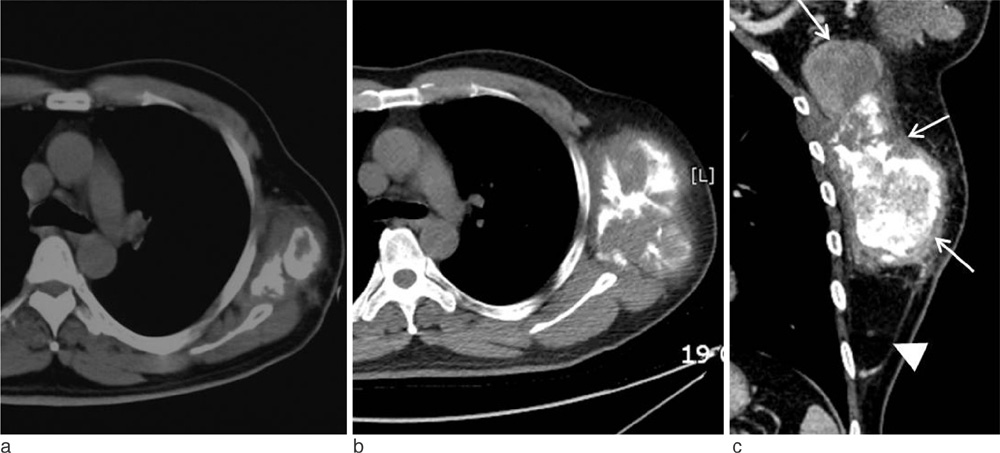J Korean Soc Magn Reson Med.
2011 Dec;15(3):251-256. 10.13104/jksmrm.2011.15.3.251.
Lipoma-like Liposarcoma with Osteosarcomatous Dedifferentiation of the Chest Wall: A Case Report
- Affiliations
-
- 1Department of Radiology, College of Medicine, Korea University, Korea. mallecot@hanmail.net
- 2Department of Pathology, College of Medicine, Korea University, Korea.
- KMID: 2000054
- DOI: http://doi.org/10.13104/jksmrm.2011.15.3.251
Abstract
- We report a case of liposarcoma with osteosarcomatous dedifferentiation of the chest wall in a 58-year-old man, which had been initially mistaken as myositis ossificans. CT and MRI demonstrated a soft tissue mass consisting of two components: a non-lipomatous area with amorphous calcification/ossification and a well-encapsulated fatty component. Based on local excision in the non-lipomatous area, myositis ossificans was initially diagnosed. As the mass was gradually enlarging, however, wide excision including the fatty component was performed and histological assessment revealed lipoma-like, well-differentiated liposarcoma with high-grade osteosarcomatous dedifferentiation. Here, we describe the radiological-pathological features of this rare neoplasm.
Keyword
Figure
Reference
-
1. Ippolito V, Brien EW, Menendez LR, Mirra JM. Case report 797: "Dedifferentiated" lipoma-like liposarcoma of soft tissue with focal transformation to high-grade "sclerosing" osteosarcoma. Skeletal Radiol. 1993. 22:604–608.2. Evans HL, Khurana KK, Kemp BL, Ayala AG. Heterologous elements in the dedifferenatiated component of dedifferentiated liposarcoma. Am J Surg Pathol. 1994. 18:1150–1157.3. Henricks WH, Chu YC, Goldblum JR, Weiss SW. Dedifferentiated liposarcoma: a clinicopathological analysis of 155 cases with a proposal for an expanded definition of dedifferentiation. Am J Surg Pathol. 1997. 21:271–281.4. Yamamoto T, Matsushita T, Marui T, et al. Dedifferenatiated liposarcoma with chondrobalstic osteosarcomatous dedifferenatiation. Pathology International. 2000. 50:558–561.5. Takanami I, Imamura T. Dedifferentiated liposarcoma of the pleura: report of a case. Surg Today. 2005. 313–316.6. Toms A, White LM, Kandel R, Bell R. Low-grade liposarcoma with osteosarcomatous dedifferentiation: radiological and histological features. Skeletal Radiol. 2003. 32:286–289.7. Yu L, Fung S, Hojnowski L, Damron T. Dedifferentiated liposarcoma of soft tissue with high-grade osteosarcomatous dedifferentiation. Radiographics. 2005. 25:1082–1086.8. Toshiyasu T, Ehara S, Yamaguchi T, Nishida J, Shiraishi H. Dedifferentiated liposarcoma of the retroperitoneum with osteosarcomatous component: report of two cases. Clinical Imaging. 2009. 33:70–74.9. Yoshida A, Ushiku T, Motoi T, Tatsuhiro T, Fukayama M, Tsuda H. Well-differentiated liposarcoma with low-grade osteosarcomatous component. Am J Surg Pathol. 2010. 34(9):1361–1366.10. Evans HL. Liposarcoma: a study of 55 cases with reassessment of its classification. Am J Surg Pathol. 1979. 3:507–523.
- Full Text Links
- Actions
-
Cited
- CITED
-
- Close
- Share
- Similar articles
-
- Erratum: Lipoma-like Liposarcoma with Osteosarcomatous Dedifferentiation of the Chest Wall: A Case Report
- Magnetic Resonance Imaging Features That Permit Differential Diagnosis of Chest Wall Liposarcoma Mimicking Lipoma in Men
- Unusual bilateral vulvar liposarcoma
- A Case of Myxoid Liposarcoma of Neck
- A Case of Retroperitoneal Liposarcoma




